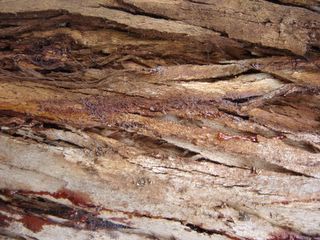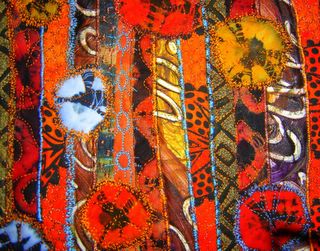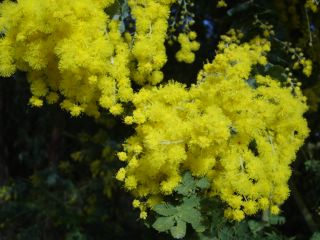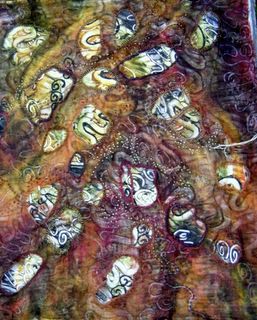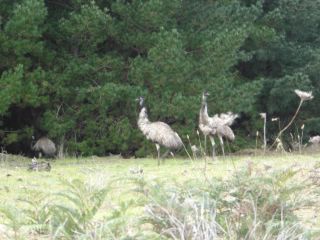
It's A Hot Continent
I have included a picture of some work I did with transfer dyes last year. Transfer dyes are used on synthetic materials. You first paint the dyes onto paper, as you would if painting a painting, and then you place the paper painted side down on the synthetic material ( in this case a very thin polyester fleece) and iron or press with a heat press the back of the paper and 'transfer' the colour ontothe polyester fleece. You can get up to three prints for each paper and the colur is permanent. It allows you control over where the colour goes and the fleece when stitched almost has th eappearance of felt. I like it a lot and am chomping at th ebit to do some more. I use teeppee transfer dyes which are available in liquid form so you can paint with them without further ado.
On a more musing sort of note yesterday when I visited
In a Minute Ago Sharon Bogon mentioned a Carft manifesto, which looked at how craft and the internet had brought people together, to create and form exchanges and friendships, and had created opportunities . I know I have certainly enjoyed these and have found the world a smaller place. However there is another aspect to all this. Some of you know I have curated a number of travelling exhibitions and have done so since 2000 and am now in the process of curating Across Australia which will travel widely including the Panorama Mesdag in the Netherlands and then to Libya, Egypt and Syria as a showcase of Australian culture in January and February 2006. I have done a lot of previous touring out of a suitcase with little institutional funding and off my own bat, and made contacts largely through email - though the Middle eastern tour is being co-ordinated by the Australian Embassy in Egypt and they have arranged sponsorship, and this will include a full colour catalogue- thank goodness- and this is almost all through email on my part and through the help of an internet friend( though we have met now a few times face to face: Jenny Bowker) but with little support from the many incorporated associations that are out there relevant to my craft.
This is not only a problem for me but possibly a problem for many other people out there with even better ideas for exhibitions and exposing the world to what we spend half our lives with (ggg). From personal experience and having served on exhibition commitees and also on committees of organisations,I actually think that the government ruling that an organisation must be an incorporated association in order to apply for funding is a huge problem. Firstly because committees by law, have to roll over their committee ( ie those positions have to change every couple of years which means inexperienced people step into the fray or old ones who have been off committee come back into it). So it means that people like myself have limited access to funding because you need to create partnerships of trust and mutual understanding which is difficult when things are changing all the time and if dealing with new people they have to be re-educated each time. I actually think that it can be counter productive in that the funding goes to perhaps not the best people to organise the exhibitions. From a personal point of view I find committees hard, because, firstly I live in what is considered an isolated region, two that usually involves almost a day of travel to attend a meeting ( and I already give my time for free in organising the exhibitions that I do), and three I have limited funds and do not like expending money on petrol to attend meetings. No one ever wants to come to Gellibrand because it is too far- I have the reverse problem.
So I have managed to tour things because of the internet and going outside of the normal system of government funding, organisational funding and using the internet as the huge tool that it is. Just another aspect of what the internet can do at times .
